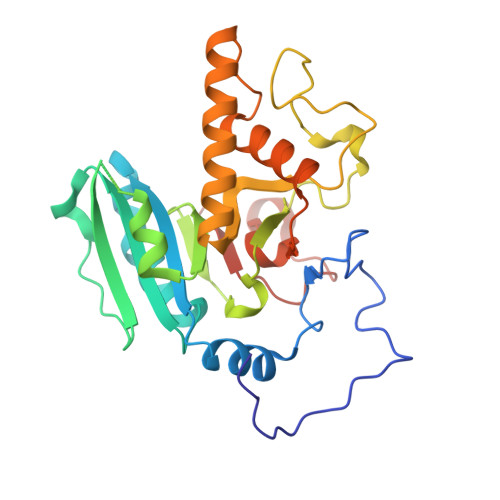Structural basis for the inactivity of human blood group O2 glycosyltransferase
Lee, H.J., Barry, C.H., Borisova, S.N., Seto, N.O.L., Zheng, R.B., Blancher, A., Evans, S.V., Palcic, M.M.(2005) J Biol Chem 280: 525-529
- PubMed: 15475562
- DOI: https://doi.org/10.1074/jbc.M410245200
- Primary Citation of Related Structures:
1WSZ, 1WT0, 1WT1, 1WT2, 1WT3, 1XZ6 - PubMed Abstract:
The human ABO(H) blood group antigens are carbohydrate structures generated by glycosyltransferase enzymes. Glycosyltransferase A (GTA) uses UDP-GalNAc as a donor to transfer a monosaccharide residue to Fuc alpha1-2Gal beta-R (H)-terminating acceptors. Similarly, glycosyltransferase B (GTB) catalyzes the transfer of a monosaccharide residue from UDP-Gal to the same acceptors. These are highly homologous enzymes differing in only four of 354 amino acids, Arg/Gly-176, Gly/Ser-235, Leu/Met-266, and Gly/Ala-268. Blood group O usually stems from the expression of truncated inactive forms of GTA or GTB. Recently, an O(2) enzyme was discovered that was a full-length form of GTA with three mutations, P74S, R176G, and G268R. We showed previously that the R176G mutation increased catalytic activity with minor effects on substrate binding. Enzyme kinetics and high resolution structural studies of mutant enzymes based on the O(2) blood group transferase reveal that whereas the P74S mutation in the stem region of the protein does not appear to play a role in enzyme inactivation, the G268R mutation completely blocks the donor GalNAc-binding site leaving the acceptor binding site unaffected.
Organizational Affiliation:
Department of Chemistry, University of Alberta, Edmonton, Alberta T6G 2G2, Canada.















